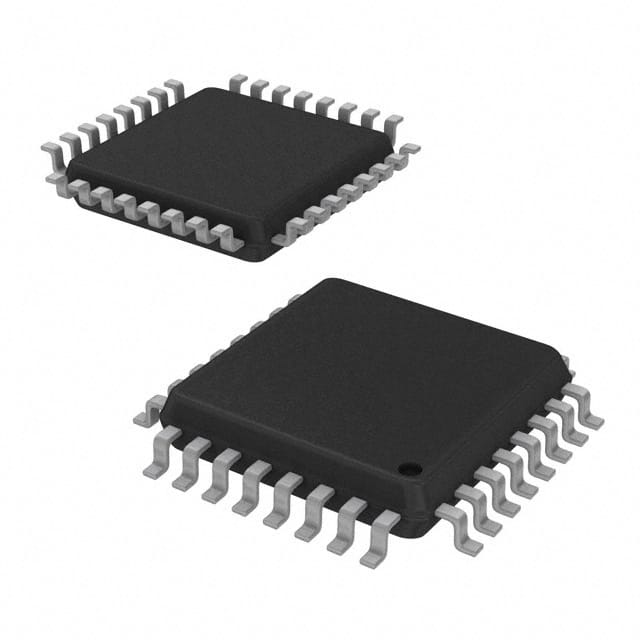ST7FLI49MK1T6TR
Product Overview
Category
The ST7FLI49MK1T6TR belongs to the category of microcontrollers.
Use
This microcontroller is designed for various embedded applications, including consumer electronics, industrial automation, and automotive systems.
Characteristics
- High-performance 8-bit microcontroller
- Low power consumption
- Integrated flash memory for program storage
- Multiple communication interfaces (UART, SPI, I2C)
- Analog-to-digital converter (ADC) for sensor interfacing
- Real-time clock (RTC) for timekeeping
- PWM outputs for controlling motors or other devices
Package
The ST7FLI49MK1T6TR is available in a compact surface-mount package.
Essence
The essence of this microcontroller lies in its ability to provide a cost-effective solution for a wide range of embedded applications. It combines high performance with low power consumption, making it suitable for battery-powered devices.
Packaging/Quantity
The ST7FLI49MK1T6TR is typically packaged in reels or tubes, with a quantity of 2500 units per reel/tube.
Specifications
- Architecture: 8-bit
- CPU Frequency: Up to 16 MHz
- Flash Memory: 32 KB
- RAM: 1.5 KB
- Operating Voltage: 2.7V to 5.5V
- Digital I/O Pins: 20
- ADC Resolution: 10-bit
- Communication Interfaces: UART, SPI, I2C
- Timers/Counters: 3
- PWM Outputs: 4
- Operating Temperature Range: -40°C to +85°C
Detailed Pin Configuration
The ST7FLI49MK1T6TR has a total of 20 pins, which are assigned different functions based on their configuration. The pin configuration is as follows:
- VDD - Power supply voltage
- GND - Ground
- RESET - Reset pin for initializing the microcontroller
- PA0 - General-purpose I/O pin
- PA1 - General-purpose I/O pin
- PA2 - General-purpose I/O pin
- PA3 - General-purpose I/O pin
- PA4 - General-purpose I/O pin
- PA5 - General-purpose I/O pin
- PA6 - General-purpose I/O pin
- PA7 - General-purpose I/O pin
- PB0 - General-purpose I/O pin
- PB1 - General-purpose I/O pin
- PB2 - General-purpose I/O pin
- PB3 - General-purpose I/O pin
- PB4 - General-purpose I/O pin
- PB5 - General-purpose I/O pin
- PB6 - General-purpose I/O pin
- PB7 - General-purpose I/O pin
- OSCIN/OSCOUT - Oscillator input/output pins
Functional Features
- High-speed processing capabilities
- Flexible I/O configurations
- On-chip memory for program storage
- Multiple communication interfaces for data exchange
- Analog-to-digital converter for sensor interfacing
- Real-time clock for timekeeping applications
- PWM outputs for precise control of motors or other devices
Advantages and Disadvantages
Advantages
- High-performance microcontroller suitable for various applications
- Low power consumption extends battery life in portable devices
- Integrated flash memory eliminates the need for external storage
- Multiple communication interfaces enhance connectivity options
- Real-time clock enables accurate timekeeping functionality
Disadvantages
- Limited RAM capacity may restrict complex application development
- 8-bit architecture may not be suitable for certain high-end applications requiring higher processing power
- Limited number of I/O pins may limit the connectivity options for some projects
Working Principles
The ST7FLI49MK1T6TR operates based on an 8-bit architecture, where instructions are executed sequentially. It fetches instructions from the flash memory and executes them using the central processing unit (CPU). The microcontroller interacts with external devices through its I/O pins and communication interfaces.
Detailed Application Field Plans
The ST7FLI49MK1T6TR can be applied in various fields, including:
Consumer Electronics:
- Remote controls
- Home automation systems
- Wearable devices
Industrial Automation:
- Programmable logic controllers (PLCs)
- Motor control systems
- Data acquisition systems
Automotive Systems:
- Engine control units (ECUs)
- Dashboard displays
- Infotainment systems
Detailed and Complete Alternative Models
- ST7FLI49MK2T6TR: Similar to the ST7FLI49MK1T6TR but with increased flash memory capacity (64 KB).
- ST7
Lista 10 Vanliga frågor och svar relaterade till tillämpningen av ST7FLI49MK1T6TR i tekniska lösningar
Sure! Here are 10 common questions and answers related to the application of ST7FLI49MK1T6TR in technical solutions:
Q1: What is the ST7FLI49MK1T6TR microcontroller used for? A1: The ST7FLI49MK1T6TR microcontroller is commonly used in various technical solutions, such as industrial automation, consumer electronics, automotive applications, and more.
Q2: What is the maximum operating frequency of the ST7FLI49MK1T6TR microcontroller? A2: The ST7FLI49MK1T6TR microcontroller has a maximum operating frequency of 16 MHz.
Q3: How many I/O pins does the ST7FLI49MK1T6TR microcontroller have? A3: The ST7FLI49MK1T6TR microcontroller has a total of 48 I/O pins.
Q4: Can the ST7FLI49MK1T6TR microcontroller be programmed using C/C++ language? A4: Yes, the ST7FLI49MK1T6TR microcontroller can be programmed using C/C++ language, along with other programming languages like assembly.
Q5: Does the ST7FLI49MK1T6TR microcontroller support analog-to-digital conversion (ADC)? A5: Yes, the ST7FLI49MK1T6TR microcontroller supports analog-to-digital conversion (ADC) with up to 8 channels.
Q6: What is the flash memory size of the ST7FLI49MK1T6TR microcontroller? A6: The ST7FLI49MK1T6TR microcontroller has a flash memory size of 32 KB.
Q7: Can the ST7FLI49MK1T6TR microcontroller communicate with other devices using serial communication protocols? A7: Yes, the ST7FLI49MK1T6TR microcontroller supports various serial communication protocols like UART, SPI, and I2C.
Q8: Does the ST7FLI49MK1T6TR microcontroller have built-in timers and counters? A8: Yes, the ST7FLI49MK1T6TR microcontroller has multiple built-in timers and counters for various timing and counting applications.
Q9: What is the operating voltage range of the ST7FLI49MK1T6TR microcontroller? A9: The ST7FLI49MK1T6TR microcontroller operates within a voltage range of 2.7V to 5.5V.
Q10: Is the ST7FLI49MK1T6TR microcontroller suitable for low-power applications? A10: Yes, the ST7FLI49MK1T6TR microcontroller is designed to be power-efficient and can be used in low-power applications.
Please note that these answers are general and may vary depending on specific application requirements and configurations.


